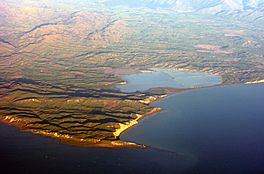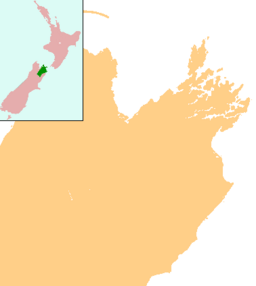Lake Grassmere / Kapara Te Hau facts for kids
Quick facts for kids Lake Grassmere / Kapara Te Hau |
|
|---|---|
 |
|
| Location | Marlborough Region, South Island |
| Coordinates | 41°44′S 174°10′E / 41.733°S 174.167°E |
| Type | lagoon |
| Primary inflows | none |
| Basin countries | New Zealand |
| Surface area | 17 km2 (6.6 sq mi) |
Lake Grassmere / Kapara Te Hau is a special lake in the northeastern South Island of New Zealand. It is located near the Cook Strait, which separates the North and South Islands. This lake is very important because it is used to make salt!
Contents
Geography of Lake Grassmere
Lake Grassmere is about 25 miles (40 km) south of Blenheim. It's a shallow lagoon, which means it's a body of water separated from the open sea by a narrow strip of land, like a sand dune beach.
The lake covers an area of about 17 square kilometres (6.6 sq mi). It doesn't have any rivers flowing into it naturally. Strong, warm winds often blow across the lake. Because it's so close to the sea, its water is very salty, which is called high salinity.
These features make Lake Grassmere perfect for naturally getting salt from the water. The lake has been divided into many smaller ponds. These are called solar evaporation ponds. Seawater is pumped into these ponds. Over several months, the water is moved from one pond to another. Each time it moves, more water evaporates, and the saltiness increases. When the water becomes super salty, salt crystals form. These crystals are then collected.
The size of Lake Grassmere can change, usually between 3,500 and 4,400 acres (14 and 18 km2). It only reaches its largest size during rare floods. The area of land that drains into the lake is small. The weather here is also perfect for salt making. It has low rainfall, about 585 millimetres (23.0 in) per year, and strong, dry winds.
Early History of Kapara Te Hau
The Māori name for the lake is Kapara Te Hau. This name means "wind-blown lake." Early whalers who visited the coast used to call it "Cobblers' Hole."
According to Māori stories passed down through generations, the lake was once a place where people grew crops. A famous navigator named Kupe is said to have poured salt water onto these crops, which then created the lake.
Before Europeans arrived, the lake was a great place to find food. Many different kinds of waterfowl, like ducks, came to the lake, making it a good hunting spot.
In 1832–33, there was a battle near the lake. Ngāti Toa, led by Te Rauparaha, had defeated another group called Ngāi Tahu in other areas. Ngāti Toa visited the lake to catch ducks that were shedding their feathers. However, a Ngāi Tahu group knew they were coming and set up a surprise attack. Te Rauparaha's scouts thought the area was empty, and their canoes landed. But when they got ashore, Ngāti Toa were surprised and many were hurt. Te Rauparaha was captured by Tūhawaiki. He pretended to give up, so he wasn't held as tightly. Then, he slipped out of his clothing, swam to a canoe, and escaped!
The Salt Industry at Lake Grassmere
Before the 1940s, Lake Grassmere was often muddy in winter and dusty in summer. Sometimes, natural salt would form on its bed.
The salt industry officially began here in 1943. Today, it uses about one-third of the lake's suitable area, which is about 3,800 acres (15 km2). In 1960, the lake produced 17,000 tons of salt.
- In 1960, New Zealand used about 61,000 tons of salt for industries and homes.
- The salt works at Grassmere could potentially produce up to 50,000 tons. They can also make other useful products. For example, they already produce small amounts of caustic soda and gypsum.
- By 2005, Lake Grassmere was providing about half of all the salt New Zealand needed.
Besides the low rainfall, Lake Grassmere is perfect for making salt using the sun.
- The lake bed is a large, flat area close to the sea, so it's easy to pump in seawater. It's also far from big rivers that could dilute the salty water.
- During summer, the sun and wind cause a lot of water to evaporate.
- The location also has good access to both sea and rail transport, making it easy to move the salt.
In the mid-1960s, new ways of harvesting salt were used. They created special ponds that could drain off rainwater before it mixed with the very salty water.
The salt harvest for 1964–65 reached 30,000 tons, which was a record at that time.
By 1970, the harvest grew to almost 52,000 tonnes. However, this still wasn't enough to meet the growing demand for salt, especially from industries like freezing works and paper mills. It became clear that Lake Grassmere alone couldn't supply all of New Zealand's salt needs.
So, large amounts of salt were brought in by ship from the Caribbean and Australia. A special factory was built at Mt Maunganui to make very pure salt. This high-purity salt was needed by companies that make dairy products and medicines. A second, smaller factory was also built at Grassmere to make this pure salt.
Some old railway cars that were used at the Grassmere salt works are now kept at the Ferrymead Two Foot Railway for people to see.
What Salt is Made at Lake Grassmere?
Lake Grassmere produces many different types of salt. These salts have slightly different chemicals, and their crystals can be different sizes and shapes. All the table salt made in New Zealand comes from solar salt, like that made at Grassmere. You can find both iodised (with added iodine) and non-iodised table salt.
Iodine is added to iodised salt to help prevent a health problem called goitre. Silicon dioxide is also added to make the salt flow easily. Special salts, like flaky salt, are also made at Lake Grassmere.
Products for animal health, such as salt licks for farm animals, are made at both Grassmere and Mt Maunganui.
At the end of summer, you can easily see the bright white piles of salt at Grassmere from State Highway 1. These huge piles are a seasonal sight and look very different from the dry, brown Marlborough hills.
Earthquakes Near Lake Grassmere
A fault line runs under Lake Grassmere. This fault caused a magnitude 6.6 earthquake on Friday, August 16, 2013, at 2:31:05 pm. The earthquake happened about 8 kilometres (5 mi) deep. It was a "strike-slip" fault, which means the ground moved sideways. This quake was similar to the 2013 Seddon earthquake that happened on July 21, 2013, and is considered a "doublet earthquake" because they were so close in time and type.
Official Name of the Lake
The official name of the lake became a dual name – Lake Grassmere / Kapara Te Hau – because of the Ngāi Tahu Claims Settlement Act 1998. This act recognized the historical importance of Māori names for places.


